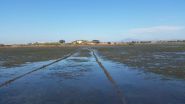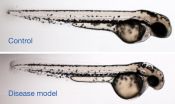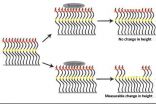(Press-News.org) ST. LOUIS, MO – October 13, 2014 –A team of scientists led by Thomas Brutnell, Ph.D., director of the Enterprise Rent-A-Car Institute for Renewable Fuels at the Donald Danforth Plant Science Center have developed a new way of identifying genes that are important for photosynthesis in maize, and in rice. Their research helps to prioritize candidate genes that can be used for crop improvement and revealed new pathways and information about how plants fix carbon. The findings, published in "Comparative analyses of C4 and C3 photosynthesis in developing leaves of maize and rice," on October 12, 2014 in Nature Biotechnology, also made public a mathematical model enabling access to datasets comparing C4 photosynthesis traits in plants like maize to C3 photosynthesis in plants like rice.
C4 crops including maize, sorghum, switchgrass and sugarcane are able to withstand drought, heat, nitrogen and carbon dioxide limitations better than C3 crops, such as rice, wheat, barley and oats, due to their ability to efficiently make use of carbon dioxide and water that make carbohydrates we eat and cell wall polysaccharides; the sugars that are important to producing next-generation biofuels.
"Our research focuses on understanding complex network interactions in grasses with a goal of engineering C4 traits into C3 grasses which can be translated into crops that impact the supply of food and fuel," said Brutnell. "The technologies that our team developed to identify regulatory genes that enhance photosynthesis in C4 crops can be extended to identify control points for other processes including nitrogen and phosphate efficiency as well as a plant's response to environmental stresses like heat and drought."
The Danforth Center has expanded their portfolio over the years by studying model C4 grasses to improve the quality, yield and biomass of emerging bioenergy feedstocks such as miscanthus and switchgrass and that can be applied to improve food security and major cereal crops.
Todd Mockler, Ph.D., Geraldine and Robert Virgil Distinguished Investigator and Doug Bryant, Ph.D., director of the bioinformatics core facility have developed algorithms and technology to better understand important genes and genomes for a variety of significant crops using model plants. "The regulatory genes that impact photosynthesis are critically important for enhancing growth and yield and improving carbon capture in both food and bioenergy crops," said Mockler.
INFORMATION:
About The Donald Danforth Plant Science Center
Founded in 1998, the Donald Danforth Plant Science Center is a not-for-profit research institute with a mission to improve the human condition through plant science. Research aims to feed the hungry and improve human health, preserve and renew the environment and position the St. Louis region as a world center for plant science. The Center's work is funded through competitive grants and contract revenue from many sources, including the National Institutes of Health, U.S. Department of Energy, National Science Foundation, U.S. Department of Agriculture, U.S. Agency for International Development, the Bill & Melinda Gates and Howard G. Buffett Foundations.
To keep up to date with Danforth Center's current operations and areas of research, please visit, http://www.danforthcenter.org, featuring information on Center scientists, news, and the "Roots & Shoots" blog. Follow us on Twitter at @DanforthCenter.
New discovery will enhance yield and quality of cereal and bioenergy crops
2014-10-14
ELSE PRESS RELEASES FROM THIS DATE:
Scientists link ALS progression to increased protein instability
2014-10-14
LA JOLLA, CA—October 13, 2014—A new study by scientists from The Scripps Research Institute (TSRI), Lawrence Berkeley National Laboratory (Berkeley Lab) and other institutions suggests a cause of amyotrophic lateral sclerosis (ALS), also known as Lou Gehrig's disease.
"Our work supports a common theme whereby loss of protein stability leads to disease," said John A. Tainer, professor of structural biology at TSRI and senior scientist at Berkeley Lab, who shared senior authorship of the new research with TSRI Professor Elizabeth Getzoff.
Getzoff, Tainer and ...
Taking infestation with a grain of salt
2014-10-14
Twenty years ago, biologists Kathy Boyer and Joy Zedler, then researchers at San Diego State University, speculated that too many insects feeding on cordgrass in the marshes of San Diego Bay could endanger the grass, and in turn endanger the bay wildlife that relies on it.
Picking up where Boyer and Zedler left off, SDSU biologist Jeremy Long is currently further exploring the dimensions of this relationship. What he's found so far suggests that it's not a simple as saying too many insects spell death for a host plant. Instead, his research suggests a complex interplay ...
Fermented milk made by Lactococcus lactis H61 improves skin of healthy young women
2014-10-14
Philadelphia, PA, October 13, 2014 – There has been much interest in the potential for using probiotic bacteria for treating skin diseases and other disorders. Japanese researchers have now found that milk that has been fermented using a probiotic dairy starter can also benefit the skin of young healthy women, reports the Journal of Dairy Science®.
Probiotics have been defined by the Food and Agriculture Organization-World Health Organization as "live microorganisms which, when administered in adequate amounts, confer a health benefit to the host."
"Although ...
Study reveals how deadly MERS virus enters human cells
2014-10-14
ITHACA, N.Y. – Cornell University researchers have uncovered details of how the deadly Middle East respiratory syndrome coronavirus (MERS-CoV) enters host cells, and offer possible new avenues for treatment.
The study, appearing online this month in the Proceedings of the National Academy of Sciences, discovered that a common protease enzyme known as furin activates the MERS-CoV to fuse with cell membranes and enter host cells.
The researchers, Gary Whittaker, Cornell professor of virology, and Jean Millet, a postdoctoral associate in Whittaker's lab, suggest ...
Turtle tumors linked to excessive nitrogen from land-based pollution
2014-10-14
Hawai'i's sea turtles are afflicted with chronic and often lethal tumors caused by consuming non-native algae "superweeds" along coastlines where nutrient pollution is unchecked. The disease that causes these tumors is considered the leading cause of death in endangered green sea turtles. The new research was just published in the scientific journal PeerJ.
Turtles that graze on blooms of invasive seaweeds end up with a diet that is rich in a particular amino acid, arginine, which promotes the virus that creates the tumors. Scientists at the University of Hawai'i at Mānoa ...
QUT study helps outdoor workers reduce their skin cancer risk
2014-10-14
Skin cancer is one of the biggest fears for one in two outdoor workers and when the boss and staff work together the sun safe message gets through, a QUT study has found.
The study, which found more than 50 per cent of outdoor workers rated UV radiation exposure at work as one of their biggest concerns, also identified how a workplace intervention could improve workers' behaviours and attitudes towards sun protection to reduce their risk of skin cancer.
QUT in collaboration with Cancer Council Queensland and Curtin University worked with 14 Queensland outdoor workplaces ...
Mediterranean diet, olive oil and nuts can help reverse metabolic syndrome
2014-10-14
For people with metabolic syndrome, a Mediterranean diet supplemented with extra-virgin olive oil or nuts may help reverse the condition, indicate findings from a clinical trial published in CMAJ (Canadian Medical Association Journal).
About 25% of adults around the world have metabolic syndrome. The syndrome exists in the presence of three or more factors such as large waist circumference, high blood pressure, low HDL-cholesterol, high levels of triglycerides and high blood sugar concentrations that can increase the risk of diabetes, heart disease and death.
Spanish ...
For one family, zebrafish help provide genetic answers
2014-10-14
Research in zebrafish has helped identify the cause of an unknown genetic disorder affecting a boy and two of his uncles, scientists report in an article published October 14 in the journal Genetics.
The findings demonstrate the growing importance of zebrafish as laboratory models of rare diseases. Such models allow geneticists to make sense of the deluge of candidate disease genes being uncovered by advances in sequencing technologies. Although rare diseases are uncommon individually, together they affect as many as 25 million people in the United States.
The project ...
Side effects of cancer prevention surgery can be helped with education program
2014-10-14
BOSTON –– More women are having ovary-removing surgery as a cancer prevention measure, but many are often unaware of sexual or psychological side effects of the procedure. A new study by researchers at Dana-Farber Cancer Institute shows a half-day educational program can help successfully deal with these issues by educating women on how to address them.
The program taught women how to manage some of the physical and emotional difficulties that can follow ovary-removing surgery and helped many participants resume satisfying sexual activity and reduce feelings ...
Scientists create new protein-based material with some nerve
2014-10-14
Berkeley — Scientists at the University of California, Berkeley, have taken proteins from nerve cells and used them to create a "smart" material that is extremely sensitive to its environment. This marriage of materials science and biology could give birth to a flexible, sensitive coating that is easy and cheap to manufacture in large quantities.
The work, to be published Tuesday, Oct. 14, in the journal Nature Communications, could lead to new types of biological sensors, flow valves and controlled drug release systems, the researchers said. Biomedical applications ...





